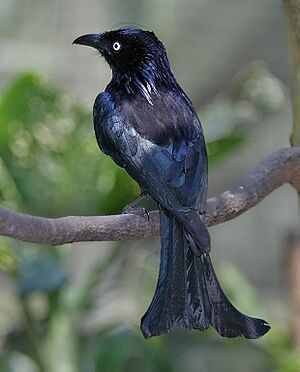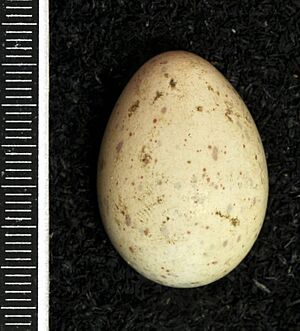Hair-crested drongo facts for kids
Quick facts for kids Hair-crested drongo |
|
|---|---|
 |
|
| Adult in Singapore | |
| Conservation status | |
| Scientific classification | |
| Genus: |
Dicrurus
|
| Species: |
hottentottus
|
| Synonyms | |
|
Corvus hottentottus Linnaeus, 1766 |
|
The hair-crested drongo (Dicrurus hottentottus) is a cool bird from Asia. It belongs to a bird family called Dicruridae, which are known as drongos. This bird used to be called the "spangled drongo," but now that name is mostly used for a different bird, Dicrurus bracteatus, which lives in Australia.
Hair-crested drongos live in many countries, including Bangladesh, India, Bhutan, China, Indonesia, and Brunei. They often fly around in small groups and are quite loud! The Australian "spangled drongo" is sometimes called a silly person in slang. This might be because of the funny chattering and cackling sounds they make.
Contents
What is a Hair-Crested Drongo?
The hair-crested drongo gets its name from the special tuft of feathers on its head. These feathers can look a bit like hair! They are medium-sized birds, usually dark in color, and have a strong, hooked beak. Drongos are known for being very clever and sometimes even mimic the calls of other birds.
Where Do Hair-Crested Drongos Live?
These amazing birds are found across a huge part of Asia. Their home stretches from the Indian subcontinent all the way to Southeast Asia and parts of China. They like to live in forests, woodlands, and even gardens. You might spot them in places like:
There are actually 12 different types, or subspecies, of the hair-crested drongo. Each one lives in a slightly different area. For example:
- D. h. hottentottus lives in India and parts of Indochina.
- D. h. borneensis is found on the island of Borneo.
- D. h. suluensis lives in the Sulu Archipelago in the Philippines.
Behavior and Sounds
Hair-crested drongos are very active birds. They often hunt for insects in the air, catching them with their beaks. They are also known to eat nectar from flowers and sometimes even small lizards.
These birds are quite noisy! They make a variety of calls, including harsh chattering sounds and sometimes even musical whistles. They are known for being very protective of their nests and will chase away much larger birds if they feel threatened.
Images for kids





